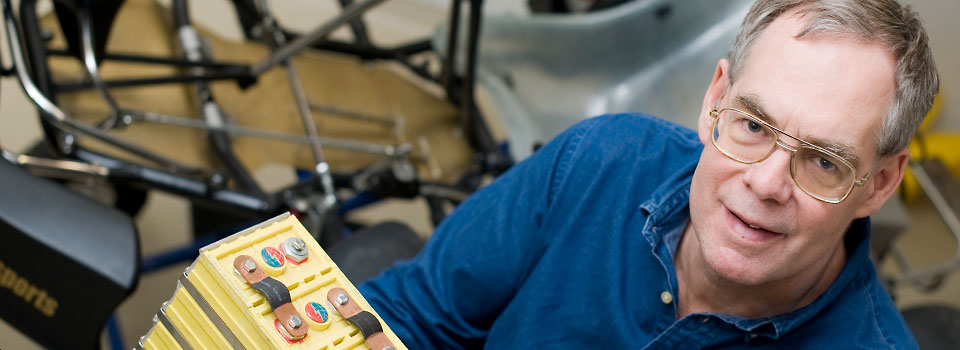Professor guides electric vehicle initiative
Professor guides electric vehicle initiative
| Author: | Emil Venere |
|---|---|
| Magazine Section: | Innovate |
| College or School: | CoE |
| Article Type: | Issue Feature |
A professor of chemical engineering, Caruthers has dedicated much of his career to understanding the mechanics of polymers, be they rubbery or rigid, hard or soft, brittle or malleable. Precisely why they bend, break, deform and stretch — knowledge that is leading to more efficient and effective use of polymers for a variety of engineering applications.
“Polymers are probably the largest class of engineering materials used today,” says Caruthers, who joined the Purdue faculty in 1977. “As an example, the increasing fuel efficiency of cars over the past few decades is due in part to weight reductions made possible by replacing metals with polymers.”
There are numerous other high-performance uses of polymers in advanced engineering applications that range for aerospace structures to medical devices to food packaging to paints and coatings to electronic packaging. In all of these applications the mechanical behavior of these materials is critical.
Caruthers’ group has recently begun research on batteries, which is an important area in emerging electric vehicle technology. The work includes developing sensors to monitor battery performance and safety and understanding the flow behavior of “highly filled particulate fluids” that are used to create the energy storage components of the battery.
The particulate filled fluids can be likened to wet sand, except that the particles are much smaller than grains of sand. When the fluid evaporates, a solid surface remains. The performance and reliability of a battery depends upon the microstructure that develops in the resulting solid, which depends upon mixing, fluid flow and drying of these particulate filled fluids.
Indiana Advanced Electric Vehicle Training and Education Consortium (I-AEVtec)
As director of the Indiana Advanced Electric Vehicle Training and Education Consortium, Caruthers leads Purdue’s electric vehicle initiative. Its goal is to educate a new generation of highly skilled workers to design, build and service electric vehicles. The consortium of Indiana colleges and universities is working to develop degree and training programs for the emerging electric vehicle industry, including students in both traditional engineering and technology degree programs. It is also focusing on engineers and technologists currently in the Indiana workforce.
As part of the I-AEVtec program, Caruthers and his team developed in 2010 the nation’s first electric vehicle grand prix. This year’s evGrandPrix features two races: The first will take place April 30 on the Purdue GrandPrix track. The second, on May 7, is the nation’s first collegiate competition at the Indianapolis Motor Speedway; time trials are on May 6.
In addition to drawing interest from Purdue students, the grand prix has also attracted the attention of middle and high school students. “The interest of young people to this emerging green technology education program has been phenomenal,” Caruthers says.
He and his team responded by partnering with 4-H and rewriting the 4-H electrical curriculum to include hands-on science modules related to electrical devices that go into an electric go-kart. Middle and high school students will build an age-appropriate electric go-kart, demonstrate their projects on the Purdue campus during the summer and drive the karts on the Purdue Grand Prix track.
“As a nation, we have to do a much better job of showing students early in their academic lives the fun, excitement and opportunities in science and engineering,” Caruthers says. “We have stumbled into a way to use electric vehicles to motivate kids in upper elementary and middle school grades to become involved in engineering, science and technology at a time when they are making decisions about whether they will pursue science and math. Using the evGrandPrix and the associated science and engineering projects, Purdue has an opportunity to potentially develop a more effective way to encourage young people to seriously consider a technical focus in their education.”

Comments